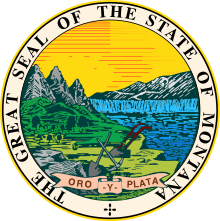Fort Maginnis
Fort Maginnis was established during the Indian wars in the Department of Dakota by the U.S. Army. It was the last of five forts: Keogh (1876), Custer (1877), Missoula (1877), Assinniboine (1879), and Maginnis (1880) - built following the defeat of Lieutenant Colonel George A. Custer by Native Americans at the Battle of Little Bighorn in June, 1876.[1]
| Fort Maginnis | |
|---|---|
| Fergus County, 25.1 miles (40.4 km) northeast of Lewistown, Montana | |
| Site information | |
| Controlled by | United States |
| Site history | |
| Built | 1880 |
| In use | 1880-1890 |
| Battles/wars | Indian Wars |
| Garrison information | |
| Past commanders |
|
| Garrison |
|
History
Fort Maginnis was established in 1880, 4 1/2 miles east of Maiden, Montana Territory, (now a ghost town) by companies of the 3rd Infantry Regiment (United States) under the command of Captain Daingerfield Parker. The fort was named for Martin Maginnis, Major of the 11th Minnesota Infantry during the Civil War, and the then U.S. Representative from Montana Territory's At-large district. Elements of the 1st United States Cavalry Regiment garrisoned the post beginning in 1881. Maginnis was abandoned on July 20, 1890 and the buildings were sold to the public.[2]
In 1879, Granville Stuart and his friend Samuel T. Hauser along with Helena banker Andrew J. Davis established the Davis, Hauser and Stuart (DHS) cattle company. Stuart was the general manager and established the ranch headquarters of the DHS on Ford Creek near Fort Maginnis.[3][4] Although surrounded by open range, the ranch was located close to the fort which provided both protection from a limited Indian threat but a ready market for cattle.[5] However this proximity to Fort Maginnis proved to be a major problem as the army claimed rights to all the hay land surrounding the fort, including that of the DHS ranch. The dispute went on for several years before the army finally returned control of the hay land to the DHS in May 1882.[4]
In 1885, Lieutenant Colonel James W. Forsyth of the 1st Cavalry served as the fort's commander. Five years later he would command the 7th Cavalry at the Wounded Knee Massacre. In 1890, at the end of the Indian Wars, Fort Maginnis was abandoned.
Epilogue
Some of its buildings were purchased, dismantled, and rebuilt in Lewistown; one is the Abraham and Mary Walton Hogeland House, which is listed on the National Register of Historic Places.[6]
The site of the fort is located about 25.1 miles (40.4 km) northeast of present-day Lewistown, Montana. Some foundations and ruins remain.
See also
Notes
- Frazer, Robert W. (1965). Forts of the West. Norman, Oklahoma: University of Oklahoma Press. p. 83.
- "Fort Maginnis". fortwiki.com.
- Reese, William S. (July 1981). "Granville Stuart of the DHS Ranch, 1879-1887". Montana The Magazine of Western History. XXXI (3).
- MacMillan, D. (Spring 1970). "The Gilded Age and Montana's DHS Ranch". Montana: The Magazine of Western History. Montana Historical Society. 20 (2): 50–57. JSTOR 4517454.
- Montana Historical Society, ed. (1976). "Food from the Land-Livestock and Agriculture in the 19th Century". Not In Precious Metals Alone-A Manuscript History of Montana. Helena, MT: Montana Historical Society. pp. 91–103. ISBN 0917298012.
- Kate Hampton (August 2006). "National Register of Historic Places Inventory/Nomination: Abraham and Mary Walton Hogeland House / Fort Maginnis Bachelor Officer's Quarters / Frank and OlaMay Hogeland House". National Park Service. Retrieved January 11, 2020. Includes historic photos.
